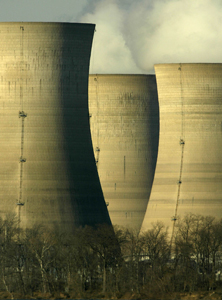By LINDSAY ALEXANDER
 Nuclear power has long caused the public eye to be leery, especially after nuclear reactor accidents such as Chernobyl and Three-Mile Island. However, nuclear power is a must.
Nuclear power has long caused the public eye to be leery, especially after nuclear reactor accidents such as Chernobyl and Three-Mile Island. However, nuclear power is a must.
The danger in nuclear power lies in the chance of a reactor core melting. If the core melts, a pool of radioactive fuel will sit at the bottom of the reactor and essentially melt through barriers meant to contain it. The highly radioactive uranium is then exposed to the unsuspecting outside world.
However, with proper monitoring, this should never happen. Groups like the International Atomic Energy Association and World Association of Nuclear Operators enforce precautions to ensure the safety and careful operation of nuclear power plants.
Nuclear reactors have control rods which absorb neutrons and regulate the fission process. They also have an emergency core cooling system to be used as back-up in case of overheating. Even in the case of Three-Mile Island where one half of the reactor core melted, no radioactive fuel escaped because of effective barriers.
Nuclear reactors are also built with sensors to detect earthquakes. If they detect one, the reactor powers down automatically. Fifty out of 54 reactors did so during the earthquakes in Japan this past March.
Although accidents like the one in Fukushima can cause concern, nuclear power is in fact one of the greenest and safest ways to create energy. Nuclear power emits no carbon dioxide or sulfur oxide directly. It indirectly emits the lowest amounts of carbon dioxide out of any other energy source, including hydro, solar and wind power, making it the greenest source of energy the world currently has. Every 22 tons of uranium used to produce nuclear power avoids the emission of one million tons of carbon dioxide from the use of coal, according to the World Nuclear Association.
The risk of exposure to high enough levels of radon, which is released in uranium mining, to cause someone’s death is negligible, and nuclear power plants have protective shielding to trap radon emission from venturing into the environment. The public has no grounds for concerns about radiation so long as the plants operate correctly.
The WNA says from 1972 to 1990, 6,400 workers have been killed in coal production, 4,000 in hydro energy production and 1,200 in natural gas energy production. The number of workers who have been killed in nuclear production sits at only 56, the result of Chernobyl.
Much of the uneasiness surrounding nuclear waste storage is based in myth. Geological repositories are designed to contain waste, even through earthquakes, for thousands of years. While highly radioactive waste does stay radiotoxic for 1,000 to 10,000 years, other industrial wastes such as mercury remain hazardous indefinitely.
In nuclear power’s 49-year history there have only been three significant nuclear reactor accidents and apart from Chernobyl, no workers or civilians died from them. The benefits of nuclear energy production are countless and often safer than alternative forms of energy production.